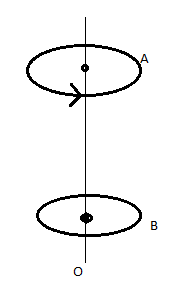
There are two loops $A$ and $B$ placed coaxially along a vertical line. Loop $A$ is allowed to fall freely towards the loop $B$. If the constant current flowing in the loop $A$ is as shown in the figure, then find the direction of flow of induced current in the loop $B$ as seen from the bottom of the loop $B$.

(A) Clockwise
(B) Anticlockwise
(C) No current will induce
(D) Can’t be determined
Answer
203.1k+ views
Hint: As the loop $A$ will fall, magnetic flux will be there in the loop $B$ due to magnetic lines pointing upwards. To counter this increase of flux, a current will be induced in the loop $B$ such that induced magnetic field lines point downwards. The direction of current is found from the right hand rule.
Complete step by step answer: :
Here we will use Lenz’s law to understand what happens when the loop $A$ comes close to the loop $B$. By the right hand thumb rule, we get the direction of the magnetic field and the magnetic lines of flux of the loop $A$. As the loop $A$ goes downward, the number of flux lines in the lower loop $B$ increases. This can now be analyzed using Lenz’s law which is basically Newton’s third law for magnetism saying that the induced electric current flows in the direction such that the magnetic flux lines it creates are opposite to the magnetic flux lines which caused the induction of the current in the first place.
Therefore the new flux lines will be directed vertically downward, to oppose the original increasing flux lines of the loop $A$ which are directed upwards. Therefore using the right hand thumb rule again and this time, pointing the thumb downward along the new reversed lines of flux, which have been generated by the new induced current in the loop $B$, we get the fingers curling clockwise when seen from the top of the loop $B$. This can also be imagined as the right hand screw rule being applied along the loop $B$ with the tip of the screw along the new reversed flux lines pointing downwards.
Therefore since the direction of the current from the top is clockwise, looking from the bottom of the loop $B$, its direction will be anticlockwise.
Thus, the correct option is (B).
Note: Nature abhors change of flux. Therefore as the magnetic flux lines of the loop $A$ passing through the loop $B$ increases, the current is induced to create a change in it so that the new flux lines oppose the original increasing lines of flux. If the flux would have been decreasing, then the induced magnetic field would try to increase those flux lines.
Complete step by step answer: :
Here we will use Lenz’s law to understand what happens when the loop $A$ comes close to the loop $B$. By the right hand thumb rule, we get the direction of the magnetic field and the magnetic lines of flux of the loop $A$. As the loop $A$ goes downward, the number of flux lines in the lower loop $B$ increases. This can now be analyzed using Lenz’s law which is basically Newton’s third law for magnetism saying that the induced electric current flows in the direction such that the magnetic flux lines it creates are opposite to the magnetic flux lines which caused the induction of the current in the first place.
Therefore the new flux lines will be directed vertically downward, to oppose the original increasing flux lines of the loop $A$ which are directed upwards. Therefore using the right hand thumb rule again and this time, pointing the thumb downward along the new reversed lines of flux, which have been generated by the new induced current in the loop $B$, we get the fingers curling clockwise when seen from the top of the loop $B$. This can also be imagined as the right hand screw rule being applied along the loop $B$ with the tip of the screw along the new reversed flux lines pointing downwards.
Therefore since the direction of the current from the top is clockwise, looking from the bottom of the loop $B$, its direction will be anticlockwise.
Thus, the correct option is (B).
Note: Nature abhors change of flux. Therefore as the magnetic flux lines of the loop $A$ passing through the loop $B$ increases, the current is induced to create a change in it so that the new flux lines oppose the original increasing lines of flux. If the flux would have been decreasing, then the induced magnetic field would try to increase those flux lines.
Recently Updated Pages
JEE Main 2025 Session 2 Form Correction (Closed) – What Can Be Edited

JEE Main Login 2026 - Step-by-Step Explanation

There are two loops A and B placed coaxially along class 12 physics JEE_Main

The average and RMS value of voltage for square waves class 12 physics JEE_Main

Formula for number of images formed by two plane mirrors class 12 physics JEE_Main

If a wire of resistance R is stretched to double of class 12 physics JEE_Main

Trending doubts
JEE Main 2025 Session 2: Application Form (Out), Exam Dates (Released), Eligibility, & More

Atomic Structure: Definition, Models, and Examples

Collision: Meaning, Types & Examples in Physics

Hybridisation in Chemistry – Concept, Types & Applications

Angle of Deviation in a Prism – Formula, Diagram & Applications

Equation of Trajectory in Projectile Motion: Derivation & Proof

Other Pages
JEE Advanced Marks vs Ranks 2025: Understanding Category-wise Qualifying Marks and Previous Year Cut-offs

JEE Advanced 2025: Dates, Registration, Syllabus, Eligibility Criteria and More

JEE Advanced Weightage 2025 Chapter-Wise for Physics, Maths and Chemistry

Average and RMS Value in Physics: Formula, Comparison & Application

Dual Nature of Radiation and Matter Class 12 Physics Chapter 11 CBSE Notes - 2025-26

How to Convert a Galvanometer into an Ammeter or Voltmeter




